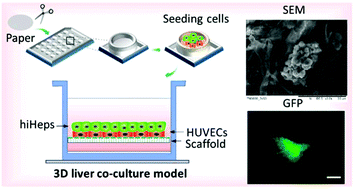当前位置:
X-MOL 学术
›
Toxicol. Res.
›
论文详情
Our official English website, www.x-mol.net, welcomes your
feedback! (Note: you will need to create a separate account there.)
Paper supported long-term 3D liver co-culture model for the assessment of hepatotoxic drugs†
Toxicology Research ( IF 2.2 ) Pub Date : 2017-09-28 00:00:00 , DOI: 10.1039/c7tx00209b Yaqing Wang 1, 2, 3, 4, 5 , Wentao Su 1, 2, 3, 4, 5 , Li Wang 1, 2, 3, 4, 5 , Lei Jiang 1, 2, 3, 4, 5 , Yang Liu 1, 2, 3, 4, 5 , Lijian Hui 5, 6, 7, 8, 9 , Jianhua Qin 1, 2, 3, 4, 5
Toxicology Research ( IF 2.2 ) Pub Date : 2017-09-28 00:00:00 , DOI: 10.1039/c7tx00209b Yaqing Wang 1, 2, 3, 4, 5 , Wentao Su 1, 2, 3, 4, 5 , Li Wang 1, 2, 3, 4, 5 , Lei Jiang 1, 2, 3, 4, 5 , Yang Liu 1, 2, 3, 4, 5 , Lijian Hui 5, 6, 7, 8, 9 , Jianhua Qin 1, 2, 3, 4, 5
Affiliation

|
Preservation of hepatic phenotype and functions in vitro has always been a great challenge for the reconstruction of liver tissue engineering and in pharmaceutical research studies. Human induced hepatocytes (hiHeps) generated from fibroblasts can be reproducible with almost normal levels of liver specific functions, which are considered as a new source of hepatocytes for biomedical applications. Moreover, paper has served as an attractive biocompatible material for cell-based applications. In this study, we established a simple paper-based scaffold array for creating a 3D liver co-culture model that enabled the assessment of drug induced hepatotoxicity. The hiHeps co-cultured with HUVECs exhibited a 3D like morphology and maintained the liver specific functions of producing albumin and urea for up to 2 months. In addition, the hiHeps in this co-cultured model maintained a higher expression of cytochrome P450 genes as compared with a monolayer culture on a plate and a single culture on paper of hiHeps, revealing a marked enhancement of hepatic functions in the 3D liver co-culture model. Moreover, the 3D liver co-culture model was exposed to acetaminophen (APAP) and pioglitazone, exhibiting near physiological hepatotoxic responses compared to those of the monolayer cultures. Taken together, the low-cost and bioactive paper scaffold could offer great opportunities as 3D in vitro platforms for tissue engineering applications and high-throughput drug testing.
中文翻译:

论文支持用于肝毒性药物评估的长期3D肝脏共培养模型†
体外肝表型和功能的保存对于肝脏组织工程的重建和药物研究一直是一个巨大的挑战。由成纤维细胞产生的人类诱导的肝细胞(hiHeps)可以具有几乎正常水平的肝特异性功能进行重现,这被认为是生物医学应用中肝细胞的新来源。此外,纸已经成为基于细胞的应用的有吸引力的生物相容性材料。在这项研究中,我们建立了一个简单的基于纸质的支架阵列,用于创建3D肝共培养模型,从而能够评估药物诱导的肝毒性。与HUVECs共培养的hiHeps表现出3D样的形态,并在长达2个月的时间内保持了肝脏产生白蛋白和尿素的特定功能。此外,与平板上的单层培养和纸上hiHeps的单层培养相比,此共培养模型中的hiHeps保持了较高的细胞色素P450基因表达,从而揭示了3D肝共培养模型中肝功能的显着增强。此外,将3D肝脏共培养模型暴露于对乙酰氨基酚(APAP)和吡格列酮,与单层培养相比,其表现出接近生理学的肝毒性反应。综上所述,低成本且具有生物活性的纸质支架可以为3D提供巨大的机会 与单层培养物相比,具有近乎生理学的肝毒性反应。综上所述,低成本且具有生物活性的纸质支架可以为3D提供巨大的机会 与单层培养物相比,具有近乎生理学的肝毒性反应。综上所述,低成本且具有生物活性的纸质支架可以为3D提供巨大的机会用于组织工程应用和高通量药物测试的体外平台。
更新日期:2017-09-28
中文翻译:

论文支持用于肝毒性药物评估的长期3D肝脏共培养模型†
体外肝表型和功能的保存对于肝脏组织工程的重建和药物研究一直是一个巨大的挑战。由成纤维细胞产生的人类诱导的肝细胞(hiHeps)可以具有几乎正常水平的肝特异性功能进行重现,这被认为是生物医学应用中肝细胞的新来源。此外,纸已经成为基于细胞的应用的有吸引力的生物相容性材料。在这项研究中,我们建立了一个简单的基于纸质的支架阵列,用于创建3D肝共培养模型,从而能够评估药物诱导的肝毒性。与HUVECs共培养的hiHeps表现出3D样的形态,并在长达2个月的时间内保持了肝脏产生白蛋白和尿素的特定功能。此外,与平板上的单层培养和纸上hiHeps的单层培养相比,此共培养模型中的hiHeps保持了较高的细胞色素P450基因表达,从而揭示了3D肝共培养模型中肝功能的显着增强。此外,将3D肝脏共培养模型暴露于对乙酰氨基酚(APAP)和吡格列酮,与单层培养相比,其表现出接近生理学的肝毒性反应。综上所述,低成本且具有生物活性的纸质支架可以为3D提供巨大的机会 与单层培养物相比,具有近乎生理学的肝毒性反应。综上所述,低成本且具有生物活性的纸质支架可以为3D提供巨大的机会 与单层培养物相比,具有近乎生理学的肝毒性反应。综上所述,低成本且具有生物活性的纸质支架可以为3D提供巨大的机会用于组织工程应用和高通量药物测试的体外平台。











































 京公网安备 11010802027423号
京公网安备 11010802027423号